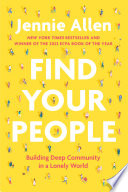

In 'Find Your People', the author emphasizes the fundamental human need for community. The book argues that having a supportive network of individuals who share your values, interests, and goals can significantly enhance your life experience. Community is not just about socializing; it’s about building relationships that provide emotional support, foster growth, and create a sense of belonging. The author highlights various studies showing that people with strong community ties tend to experience lower levels of stress, higher levels of happiness, and even better physical health. The book provides practical steps on how to cultivate meaningful connections, urging readers to seek out environments where they can meet like-minded individuals and engage in activities that resonate with their passions. By prioritizing community, individuals can navigate life's challenges more effectively and enjoy richer, more fulfilling lives.
Continue readingOne of the core messages of the book is the importance of identifying your 'tribe'—a group of people who understand and support you. The author encourages readers to reflect on their values, interests, and life goals to help pinpoint who would be a good fit for their community. This process involves introspection and a willingness to step outside comfort zones to meet new people. The book provides exercises and prompts to help readers clarify their identity and what they seek in relationships. By understanding who your tribe is, you can intentionally seek out connections that are not only enjoyable but also enriching and growth-oriented. The author argues that finding your tribe is a critical step toward personal fulfillment and success, as these connections can provide mentorship, collaboration opportunities, and emotional support.
Continue readingVulnerability is presented as a vital component of forming deep and meaningful relationships. The author discusses how being open about one’s struggles, fears, and aspirations can foster trust and connection among individuals. By sharing personal stories and experiences, people can create bonds that are authentic and supportive. The book emphasizes that while vulnerability can be uncomfortable, it is necessary for genuine connection. Readers are encouraged to embrace their imperfections and share their true selves with others, which can lead to stronger, more resilient communities. The author provides examples and anecdotes illustrating how vulnerability has led to transformative relationships in various contexts, from friendships to professional networks.
Continue readingThe author stresses the importance of creating safe spaces where individuals feel comfortable expressing themselves without judgment. These environments are crucial for fostering open dialogue and connection among community members. The book outlines strategies for establishing such spaces, including setting ground rules for communication, actively listening, and showing empathy. By cultivating a culture of safety and respect, communities can thrive, allowing members to share their thoughts and feelings freely. The author argues that safe spaces not only enhance interpersonal relationships but also encourage creativity and collaboration, leading to more innovative solutions to shared challenges.
Continue readingDiversity is highlighted as a strength in building a robust community. The author argues that engaging with individuals from various backgrounds, perspectives, and experiences can enrich personal and collective growth. The book encourages readers to seek out diverse connections, as these relationships can challenge assumptions, broaden horizons, and foster empathy. The author provides insights into how diverse communities can lead to more creative problem-solving and resilience in the face of adversity. By valuing diversity, individuals can create a more inclusive community that reflects a wide range of experiences and ideas, ultimately leading to a richer and more fulfilling social fabric.
Continue readingIn the modern age, technology plays a significant role in how we connect with others. The author discusses the dual nature of technology in community building—while it can facilitate connections across distances, it can also create superficial interactions. The book offers guidance on how to leverage technology effectively to strengthen relationships. This includes using social media to find and engage with communities of interest, as well as utilizing virtual platforms for meaningful conversations. The author warns against replacing face-to-face interactions with digital ones, advocating for a balanced approach that incorporates both in-person and online connections to foster a sense of community.
Continue readingBuilding a community is just the beginning; maintaining those relationships is equally important. The author provides insights into the effort required to sustain connections over time, including regular communication, shared experiences, and mutual support. The book emphasizes that relationships require nurturing and attention, and offers practical tips for staying connected, such as scheduling regular meet-ups or check-ins. The author also discusses the importance of being proactive in addressing conflicts and misunderstandings, as these can threaten the stability of relationships. By committing to sustaining connections, individuals can ensure that their communities remain vibrant and supportive throughout life’s changes.
Continue reading